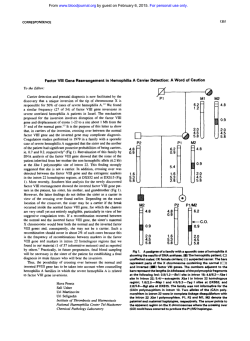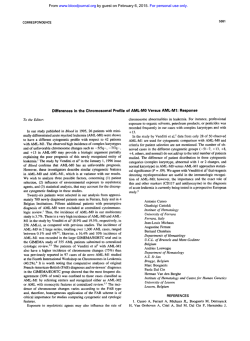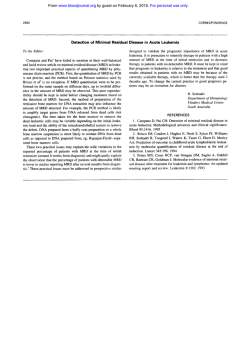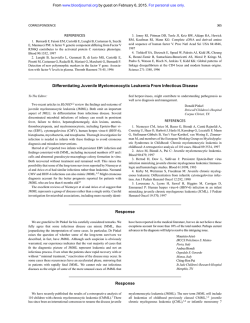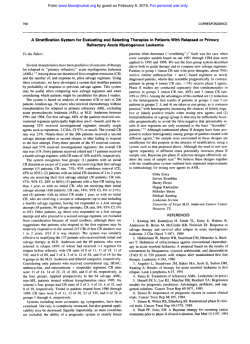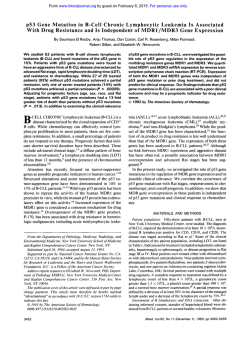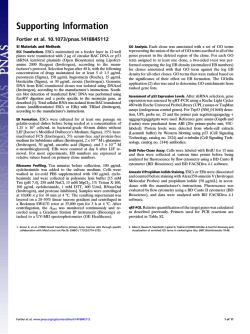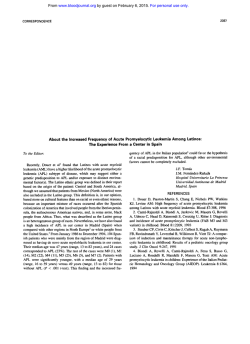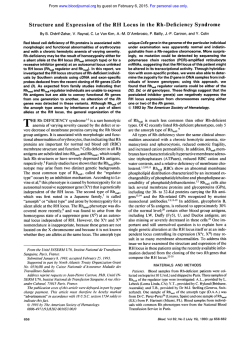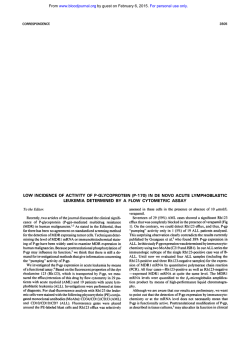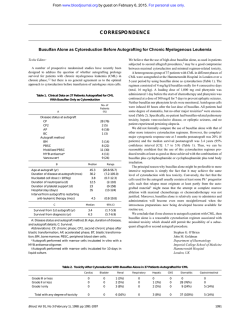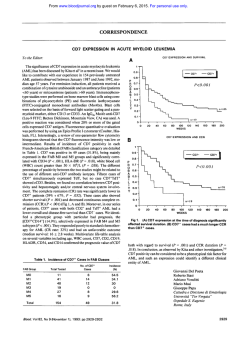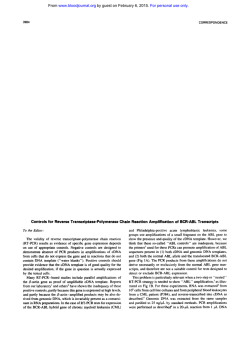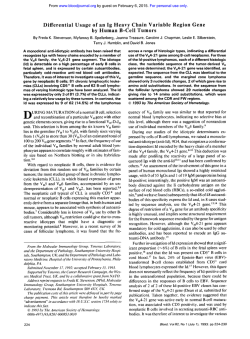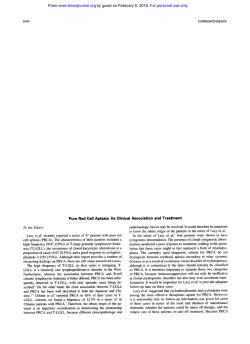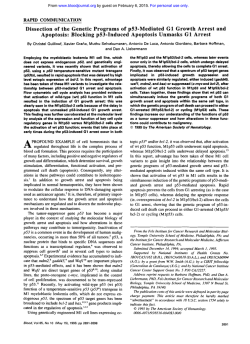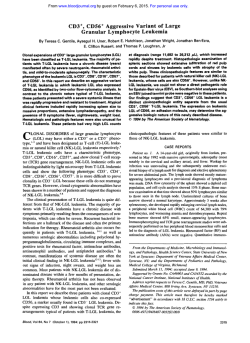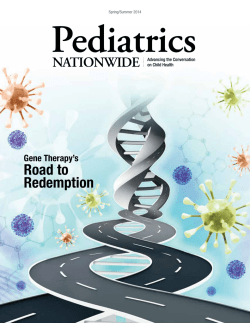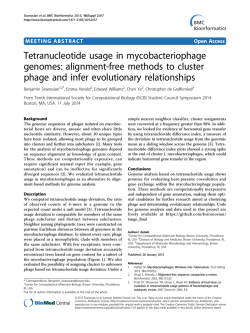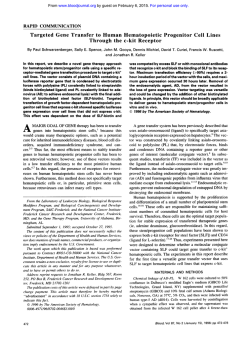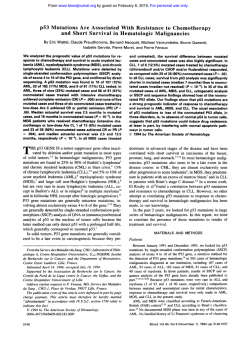
Juvenile Genetic Hemochromatosis Is Clinically and
From www.bloodjournal.org by guest on February 6, 2015. For personal use only. CORRESPONDENCE 2979 ACKNOWLEDGMENT Supported by grants from the Medical Research Council of Canada and the National Cancer Institute of Canada. Trenna Sutcliffe Loning Fu Jacinth Abraham Homayoun Vaziri Samuel Benchimol Division of Cellular/Molecular Biology Ontario Cancer Institute Princess Margaret Hospital Department of Medical Biophysics University of Toronto Toronto, Ontario, Canada REFERENCES 1. Lai JL, Preudhomme C, Zandecki M, Flactif M, Vanrumbeke M, Lepelley P, Wattel E, Fenaux P: Myelodysplastic syndromes and acute myeloid leukemia with 17p deletion. An entity characterized by specific dysgranulopoiesis and a high incidence of p53 mutation. Leukemia 9:370, 1995 2. Fenaux P, Jonveaux P, Quiquandon I, Lai JL, Pignon JM, LoucheuxLefebvre MH, Bauters F, Berger R, Kerckaert JP: p53 gene mutations in acute myeloid leukemia with 17p monosomy. Blood 78:1652, 1991 3. Soenen V, Preudhomme C, Rournier C, Daudignon A, Lai JL, Fenaux P: 17p deletion in acute myeloid leukemia with myelodysplastic syndrome. Analysis of breakpoints and deleted segments by fluorescence in situ. Blood 91:1008, 1998 4. Zhu YM, Bradbury D, Russell N: Expression of different conformations of p53 in the blast cells of acute myeloblastic leukaemia is related to in vitro growth characteristics. Br J Cancer 68:851, 1993 5. Zhang W, Hu G, Estey E, Hester J, Deisseroth A: Altered conformation of the p53 protein in myeloid leukemia cells and mitogen-stimulated normal blood cells. Oncogene 7:1645, 1992 6. Bueso-Ramos CE, Yang Y, deLeon E, McCowan P, Stass SA, Albitar M: The human MDM-2 oncogene is overexpressed in leukemias. Blood 82:2617, 1993 7. Watanabe T, Ichikawa A, Saito H, Hotta T: Overexpression of the MDM2 oncogene in leukemia and lymphoma. Leuk Lymphoma 21:391, 1996 8. Seliger B, Papadileris S, Vogel D, Hess G, Brendel C, Storkel S, Ortel J, Kolbe K, Huber C, Huhn D, Neubauer A: Analysis of the p53 and MDM-2 gene in acute myeloid leukemia. Eur J Haematol 57:230, 1996 9. Kuerbitz SJ, Plunkett BS, Walsh WV, Kastan MB: Wild-type p53 is a cell cycle checkpoint determinant following irradiation. Proc Natl Acad Sci USA 89:7491, 1992 10. Pietenpol JA, Tokino T, Thiagalingam S, El-Deiry WS, Kinzler KW, Vogelstein B: Sequence-specific transcriptional activation is essential for growth suppression by p53. Proc Natl Acad Sci USA 91:1998, 1994 11. Crook T, Marston NJ, Sara EA, Vousden KH: Transcriptional activation by p53 correlates with suppression of growth but not transformation. Cell 79:817, 1994 12. Yang GS, Minden MD, McCulloch EA: Influence of schedule on regulated sensitivity of AML blasts to cytosine arabinoside. Leukemia 7:1012, 1993 13. Funk WD, Pak DT, Karas RH, Wright WE, Shay JW: A transcriptionally active DNA-binding site for human p53 protein complexes. Mol Cell Biol 12:2866, 1992 14. Di Leonardo A, Linke SP, Clarkin K, Wahl GM: DNA damage triggers a prolonged p53-dependent G1 arrest and long-term induction of Cip1 in normal human fibroblasts. Genes Dev 8:2540, 1994 15. El-Deiry WS, Harper JW, O’Connor PM, Velculescu VE, Canman CE, Jackman J, Pietenpol JA, Burrell M, Hill DE, Wang Y, Wiman KG, Mercer WE, Kastan MB, Kohn KW, Elledge SJ, Kinzler KW, Vogelstein B: WAF1/CIP1 is induced in p53-mediated G1 arrest and apoptosis. Cancer Res 54:1169, 1994 16. Dulic V, Kaufmann WK, Wilson SJ, Tlsty TD, Lees E, Harper JW, Elledge SJ, Reed SI: p53-dependent inhibition of cyclin-dependent kinase activities in human fibroblasts during radiation-induced G1 arrest. Cell 76:1013, 1994 17. Slebos RJ, Lee MH, Plunkett BS, Kessis TD, Williams BO, Jacks T, Hedrick L, Kastan MB, Cho KR: p53-dependent G1 arrest involves pRB-related proteins and is disrupted by the human papillomavirus 16 E7 oncoprotein. Proc Natl Acad Sci USA 91:5320, 1994 18. Fu L, Benchimol S: Participation of the human p53 38UTR in translational repression and activation following g-irradiation. EMBO J 16:4117, 1997 19. Goldman SC, Chen CY, Lansing TJ, Gilmer TM, Kastan MB: The p53 signal transduction pathway is intact in human neuroblastoma despite cytoplasmic localization. Am J Pathol 148:1381, 1996 20. Maestro R, Gloghini A, Doglioni C, Piccinin S, Vukosavljevic T, Gasparotto D, Carbone A, Boiocchi M: Human non-Hodgkin’s lymphomas overexpress a wild-type form of p53 which is a functional transcription activator of the cyclin-dependent kinase inhibitor p21. Blood 89:2523, 1997 21. Butz K, Shahabeddin L, Geisen C, Spitkovsky D, Ullmann A, Hoppe-Seyler F: Functional p53 protein in human papillomaviruspositive cancer cells. Oncogene 10:927, 1995 Juvenile Genetic Hemochromatosis Is Clinically and Genetically Distinct From the Classical HLA-Related Disorder To the Editor: Genetic hemochromatosis (GH) is a common HLA-linked recessive disorder characterized by progressive parenchymal iron loading and the appearance of clinical manifestations in the fifth decade of life, predominantly in males. HFE has been recently identified as the candidate gene, with most patients being homozygous for a Cys-282 = Tyr (C282Y) mutation and others being compound heterozygotes for C282Y and a second mutation, His-63 = Asp (H63D).1 Homozygosity for C282Y is found in more than 90% of North European patients,2 but in only 64% of severely iron-loaded Italian individuals.3 This finding may suggest that various genetic iron overload syndromes exist in addition to the HFE-related one. Fifteen years ago, we described cases of juvenile GH suggesting that this was a distinct disease entity.4 In the juvenile condition, males and females appear to be equally affected. Patients present with hypogonadotropic hypogonadism and, unless proper treatment is started, die early because of cardiac dysfunction. We now provide further evidence that the juvenile condition is clinically and genetically distinct from the classical adult disorder. The pedigrees of our two Italian families with juvenile GH are shown in Fig 1. The clinical features of family 1 were reported in 1983,4 whereas family 2 has never been described. Of the four affected individuals, three presented with hypogonadotropic hypogonadism at 14 to 21 years of age. The affected male of family 2 presented with cardiac failure at 20 years of age and died at 21 years of age of congestive cardiomyopathy. From www.bloodjournal.org by guest on February 6, 2015. For personal use only. 2980 CORRESPONDENCE Fig 1. Pedigree of the two families with juvenile genetic hemochromatosis. Circles denote female family members and squares denote male family members. Solid symbols indicate probands. In family 2, the parents were consanguineous (first cousins). Each rectangle indicates the HLA-A locus and the presence (1) or absence (2) of the C282Y and H63D mutations. All individuals but the probands had normal body iron status. Some individuals in family 2 were heterozygous for b-thalassemia (bNbT), whereas the remaining ones had normal b-gene (bNbN). There is no relationship in family 1 between HLA-A antigens and iron overload. In fact, although the two probands are HLA identical, the youngest sibling has the same HLA constellation, but a fully normal body iron status at 30 years of age. Family 2 is not informative with respect to HLA linkage, but helps to exclude any interaction between hemochromatosis and b-thalassemia. All of the family members we examined using the approach of Lynas5 were found to be negative for the C282Y and H63D mutations in the HFE gene (Fig 1). In a study on 7 Italian patients belonging to 5 unrelated families with juvenile GH, Camaschella et al6 have indepen- dently excluded the HFE gene as responsible for this condition. Segregation analysis of 6p markers closely associated with HFE showed, in fact, that juvenile GH is unlinked to 6p and thus genetically distinct from HFE. Both patients of family 1 and the young lady of family 2 underwent regular phlebotomies. Based on the amount of iron mobilized by bleedings, we estimated that these subjects had body iron stores ranging from 220 to 329 mg/kg of body weight at the time of diagnosis at 17 to 21 years of age. Once the three patients became iron deficient at the end of the intensive phlebotomy program, they underwent regular venesec- From www.bloodjournal.org by guest on February 6, 2015. For personal use only. CORRESPONDENCE 2981 tions to maintain serum ferritin levels less than 100 µg/L. At the time of our writing, they have been observed in this way for 7 to 16 years. Based on phlebotomy requirements for maintenance of normal iron balance, the rate of estimated iron accumulation (positive iron balance) ranged from 3.2 to 3.9 mg/d. This was clearly higher than the rate of 0.8 to 1.6 (1.2 6 0.3) mg/d found in 5 adult males who are homozygous for the C282Y mutation. This remarkable difference in iron overprocurement (1 to 2 v 3 to 4 mg/d) suggests completely different pathogenetic mechanisms. In conclusion, juvenile GH is an autosomal recessive condition clinically and genetically different from the classical adult disorder. HLA-typing and HFE-based genotyping are useless, and diagnosis must rely on conventional evaluation of body iron status. Identification of the candidate gene through positional cloning could unveil a new crucial protein of iron metabolism in humans. ACKNOWLEDGMENT Supported by grants from IRCCS Policlinico S. Matteo, Pavia, and MURST, Rome, Italy. Mario Cazzola Paola Cerani Andrea Rovati Angioletta Iannone Giovanni Claudiani Gaetano Bergamaschi Department of Internal Medicine and Medical Oncology Department of Immunohaematology and Transfusion University of Pavia IRCCS Policlinico S. Matteo Pavia, Italy Atri Hospital Atri, Italy REFERENCES 1. Feder JN, Gnirke A, Thomas W, Tsuchihashi Z, Ruddy DA, Basava A, Dormishian F, Domingo R Jr, Ellis MC, Fullan A, Hinton LM, Jones NL, Kimmel BE, Kronmal GS, Lauer P, Lee VK, Loeb DB, Mapa FA, McClelland E, Meyer NC, Mintier GA, Moeller N, Moore T, Morikang E, Prass CE, Quintana L, Starnes SM, Schatzman RC, Brunke KJ, Drayna DT, Risch NJ, Bacon BR, Wolff RK: A novel MHC class I-like gene is mutated in patients with hereditary haemochromatosis. Nat Genet 13:399, 1996 2. Jouanolle AM, Fergelot P, Gandon G, Yaouanq J, Le Gall JY, David V: A candidate gene for hemochromatosis: Frequency of the C282Y and H63D mutations. Hum Genet 100:544, 1997 3. Piperno A, Sampietro M, Pietrangelo A, Arosio C, Lupica L, Montosi G, Vergani A, Fraquelli M, Girelli D, Pasquero P, Roetto A, Gasparini P, Fargion S, Conte D, Camaschella C: Heterogeneity of hemochromatosis in Italy. Gastroenterology 114:996, 1998 4. Cazzola M, Ascari E, Barosi G, Claudiani G, Dacco` M, Kaltwasser JP, Panaiotopoulos N, Schalk KP, Werner E: Juvenile idiopathic hemochromatosis: A life-threatening disorder presenting as hypogonadotropic hypogonadism. Hum Genet 65:149, 1983 5. Lynas C: A cheaper and more rapid polymerase chain reactionrestriction fragment length polymorphism method for the detection of the HLA-H gene mutations occurring in hereditary hemochromatosis. Blood 90:4235, 1997 6. Camaschella C, Roetto A, Cicilano M, Pasquero P, Bosio S, Gubetta L, Di Vito F, Girelli D, Totaro A, Carella M, Grifa A, Gasparini P: Juvenile and adult hemochromatosis are distinct genetic disorders. Eur J Hum Genet 5:371, 1997 Hypermethylation of p15INK4B Gene in a Patient With Acute Myelogenous Leukemia Evolved From Paroxysmal Nocturnal Hemoglobinuria To the Editor: Paroxysmal nocturnal hemoglobinuria (PNH) is an acquired disease resulting from somatic mutations in the PIG-A gene involving primitive hematopoietic stem cells. The PNH clones may have growth or survival advantages relative to normal clones that may promote their expansion, resulting in the development of overt PNH. However, little is known about how PNH clones gain growth advantage. Recent studies demonstrated preferential hematopoiesis by PNH clones in vivo.1,2 However, proliferation may be affected similarly in PIG-A–deficient clones and in normal clones,3 suggesting that PIG-A abnormalities alone may not be sufficient to confer a growth advantage on PNH clones. A proportion of PNH patients terminate in severe pancytopenia with dysplasia, ie, myelodysplastic syndrome (MDS), and rarely progress to acute leukemia. We previously reported in BLOOD that specific p15INK4B gene inactivation by promoter hypermethylation may be associated with the development of MDS,4 because it may confer a growth advantage on cells. One overt leukemia patient analyzed in this study in whom PNH evolved through MDS (PNH/MDS-OL) showed intense hypermethylation of the p15INK4B gene. Surface marker analysis of his leukemic blasts showed low levels of expression of CD59, suggesting that leukemic blasts were derived from the PNH clone. So, to clarify at what point the p15INK4B gene was densely methylated and inactivated in this PNH/MDS-OL patient and whether this p15INK4B gene methylation is related to the expansion of PNH clones, we analyzed this patient and an additional 17 PNH patients. We obtained clinical samples after receiving informed consent from a total of 18 patients (4 men and 14 women) who were positive for sugar water test and/or acidified serum (Ham) test and were diagnosed as PNH based on clinical manifestations. They included 12 female patients (unique patient no. [UPN] 1 through 12) analyzed in our previous study in which we demonstrated the existence of monoclonal populations with PNH phenotype by clonality analysis using X-chromosome inactivation and assessment of expression of glycophosphatidylinositolanchored proteins by flow cytometry.5 We extracted DNA from polymorphonuclear cells (PMNCs) and mononuclear cells (MNCs) (or T lymphocytes), as described previously,5 and analyzed the methylation status of the p15INK4B gene by the simple and sensitive methylationspecific polymerase chain reaction (MSP) method.6 Because MSP can detect 1023 methylated alleles among unmethylated alleles,6 changes of the methylation status in PNH clones could be detected even if they are present at a very low incidence. After bisulfite modification, we amplified their DNAs with each primer set specific for unmethylated and methylated DNA in a thermal cycler (TAKARA, Kyoto, Japan). From www.bloodjournal.org by guest on February 6, 2015. For personal use only. 1998 92: 2979-2981 Juvenile Genetic Hemochromatosis Is Clinically and Genetically Distinct From the Classical HLA-Related Disorder Mario Cazzola, Paola Cerani, Andrea Rovati, Angioletta Iannone, Giovanni Claudiani and Gaetano Bergamaschi Updated information and services can be found at: http://www.bloodjournal.org/content/92/8/2979.full.html Articles on similar topics can be found in the following Blood collections Information about reproducing this article in parts or in its entirety may be found online at: http://www.bloodjournal.org/site/misc/rights.xhtml#repub_requests Information about ordering reprints may be found online at: http://www.bloodjournal.org/site/misc/rights.xhtml#reprints Information about subscriptions and ASH membership may be found online at: http://www.bloodjournal.org/site/subscriptions/index.xhtml Blood (print ISSN 0006-4971, online ISSN 1528-0020), is published weekly by the American Society of Hematology, 2021 L St, NW, Suite 900, Washington DC 20036. Copyright 2011 by The American Society of Hematology; all rights reserved.
© Copyright 2025

